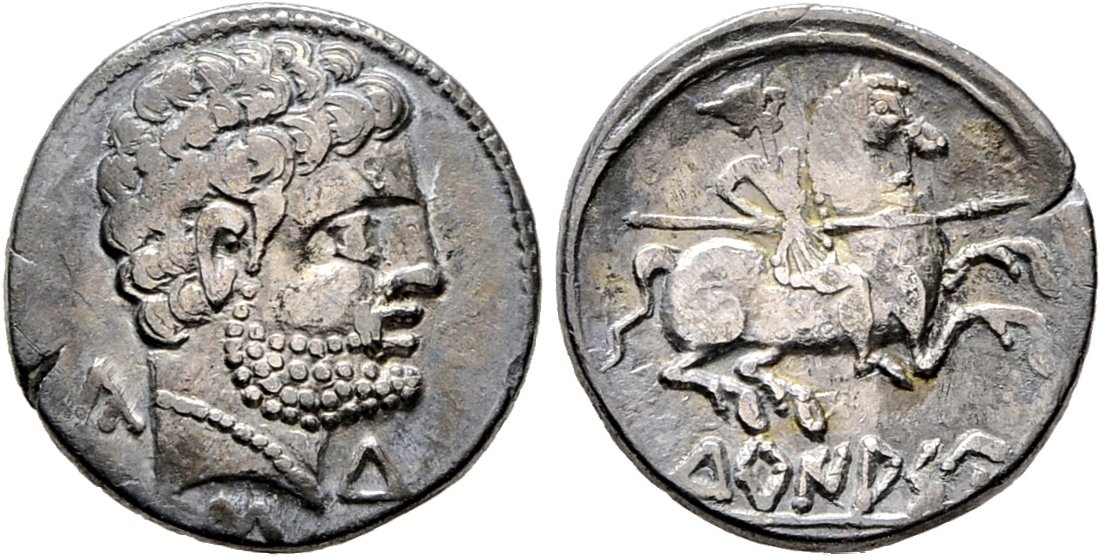S 1771 - Turiazu, silver, denarii (Group VI) (80-70 BCE)
From SILVER
80 BCE - 70 BCE Silver 1,725 kg
Description
| ObverseInscription or printing placed on the obverse.: | Bearded head right |
| ReverseInscription or printing placed on the reverse.: | iberian legend TURIASU below (Iberic).Horseman right, holding spear |
Mint and issuing power
| MintIdentifies the place of manufacture or issue of a numismatic object.: | Turiazu | Ancient regionAncient region.: | Hispania Citerior | Modern countryModern country: Spain | AuthorityIdentifies the issuing power. The authority can be "pretended" when the name or the portrait of X is on the coin but he/she was not the issuing power. It can also be "uncertain" when there is no mention of X on the coin but he/she was the issuing power according to the historical sources: | Roman Republic |
Chronology
| FromIdentifies the initial date in a range assigned in a numismatic context. | 80 BCE | toIdentifies the final date in a range assigned in a numismatic context.. | 70 BCE | PeriodTime period of the numismatic object.: Hellenistic 323-30 BC |
Physical description
| MetalThe physical material (usually metal) from which an object is made.: | Silver |
Median weightMedian of the weights of numismatic objects (in grams). in grams | 3.80 | DenominationTerm indicating the value of a numismatic object. Examples: tetradrachm, chalkous, denarius.: | denarius |
StandardStandard.: | Roman |
Image

S1771 Turiazu (Group VI).jpg [1]
References
| Die study referencePublication of the study: | Gozalbes 20091Gozalbes 2009, p. 232-233 (Group VI) | ||
| Coin series referenceReference to coin series study: | |||
Obverse dies distribution
| FrequencyFrequency of specimen in distribution. ᵖ | Number of obversesNumber of obverse dies. ᵖ (o) | % (o) | Number of coinsNumber of coins. (n) | % (n) | Die nameName(s) of the die(s). |
| 1 | 5 | 26.32 | 5 | 7.25 | 377, 378, 391, 392, 393 |
| 2 | 3 | 15.79 | 6 | 8.7 | 376, 379, 394 |
| 3 | 3 | 15.79 | 9 | 13.04 | 383, 385, 390 |
| 4 | 2 | 10.53 | 8 | 11.59 | 384, 388 |
| 6 | 3 | 15.79 | 18 | 26.09 | 380, 381, 387 |
| 7 | 1 | 5.26 | 7 | 10.14 | 386 |
| 8 | 2 | 10.53 | 16 | 23.19 | 382, 389 |
| Total | 19 of 19 | 100.01 | 69 of 69 | 100 |
Reverse dies distribution
no distribution is available
Quantification
| Number of obversesNumber of obverse dies. ᵖ (o) | 19 | Number of singletons (o1)The number of singleton coins. ᵖ | 5 |
| Number of reverse diesNumber of reverse dies. (r) | 14 | Number of coinsNumber of coins. (n) | 69 |
| Coins per obverse dieNumber of coins per obverse die. (n/o) | 3.63 | Coins per reverse dieNumber of coins per reverse die. (n/r) | 4.93 |
| Reverse per obverse ratioRatio of obverse dies divided by reverse dies. (r/o) | 0.74 | Percentage of singletons (o1)number of coins (n) divided by the number of singletons (o1) ᵖ | 26.32 % |
| Original number of dies (O) (Carter 1983 formula)The estimation of the number of coins according to Carter 1983 ᵖ | 22.7 | Coins struck if 20,000 as average productivity per dieCoins made if the average productivity for obverses (according to Carter) is 20,000. ᵖ | 454,000 |
| Original number of dies (O) (Esty 2011 formula)The estimation of the number of coins according to the singleton formula in Esty 2011 ᵖ (O) | 26.22 | Survival rate if 20,000 as average productivity per dieSurvival rate if average productivity is 20,000. ᵖ | 0.00015 |
| Coverage (o = % of O) (Esty 1984 formula)Esty 1984 - coverage (% of O) ᵖ (o = % of O) | 92.75% | Die productivity if survival rate 1/2,000Average productivity if survival rate is 1/2,000. ᵖ | 6,079.3 |
| Weight of silver (in kg) if 20,000 coins per die (O = Carter formula)Carter 1983 * Median weight * 20000 (*10 if gold or electrum) ᵖ | 1,725 kg <br /> 1,725 kg | Die productivity if survival rate 1/5,000Average productivity if survival rate is 1/5,000. ᵖ | 15,198.24 |
Remarks
Most likely one single workstation